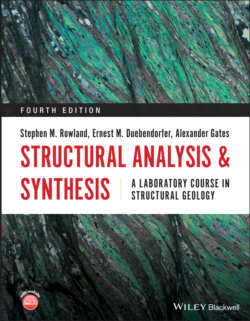Читать книгу Structural Analysis and Synthesis - Stephen M. Rowland - Страница 20
Problem 1.5
ОглавлениеRead back the structural elements on the map in Figure P1.2 and determine what the symbol represents. Fill in the table below with the results.
| Location | Strike/trend | Dip/plunge | Element |
| a | |||
| b | |||
| c | |||
| d | |||
| e |
Figure 1.6 Topographic map showing linear ridges and the line to measure structural grain of a ridge.
Karst topography is common in temperate areas underlain by limestone. One of the main features of karst is the formation of sinkholes. In many cases, the location of sinkholes is controlled by joints, joint systems/fracture trends, and brittle faults. In particular, sinkholes are common at the intersection of joints or faults. Aligned sinkholes can define zones of joints (fracture zones). By measuring the bearing of aligned sinkholes, the alignment of such brittle features may be determined.
In some cases, an indication of dip can also be determined from the topography. If the more resistant units that make up the ridges are shallowly dipping, there will typically be a dip slope and a strike or scarp slope. The steeper side of the ridge results from erosion of the unit face and is the strike slope. The shallower side of the ridge generally follows the dip of the bed. The dip direction is in the direction of the shallow side and the strike approximately follows the structural grain of a ridged area.
